ECU LINCOLN MKT 2014 Owners Manual
[x] Cancel search | Manufacturer: LINCOLN, Model Year: 2014, Model line: MKT, Model: LINCOLN MKT 2014Pages: 498, PDF Size: 7.3 MB
Page 3 of 498
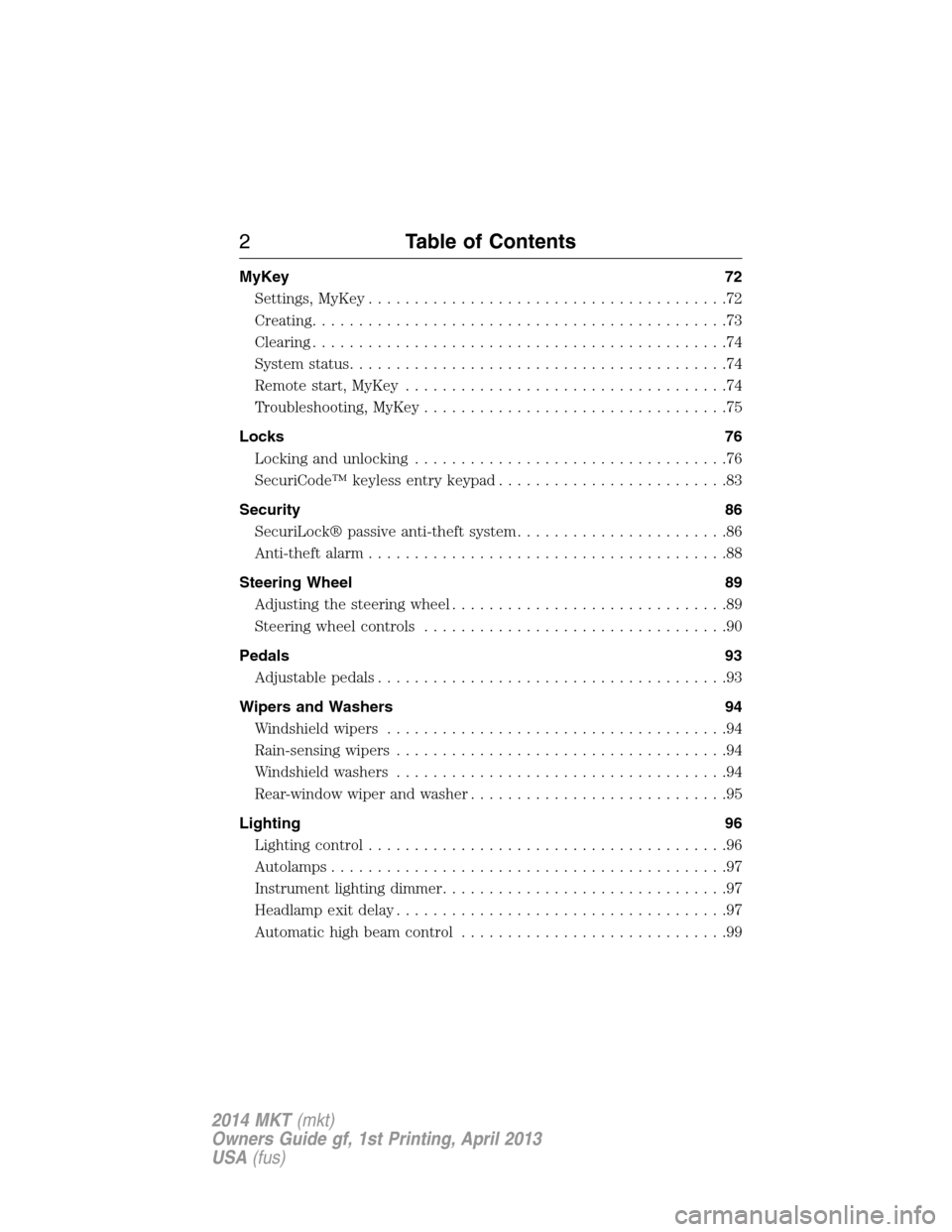
MyKey 72
Settings, MyKey.......................................72
Creating.............................................73
Clearing.............................................74
System status.........................................74
Remote start, MyKey...................................74
Troubleshooting, MyKey.................................75
Locks 76
Locking and unlocking..................................76
SecuriCode™ keyless entry keypad.........................83
Security 86
SecuriLock® passive anti-theft system.......................86
Anti-theft alarm.......................................88
Steering Wheel 89
Adjusting the steering wheel..............................89
Steering wheel controls.................................90
Pedals 93
Adjustable pedals......................................93
Wipers and Washers 94
Windshield wipers.....................................94
Rain-sensing wipers....................................94
Windshield washers....................................94
Rear-window wiper and washer............................95
Lighting 96
Lighting control.......................................96
Autolamps...........................................97
Instrument lighting dimmer...............................97
Headlamp exit delay....................................97
Automatic high beam control.............................99
2Table of Contents
2014 MKT(mkt)
Owners Guide gf, 1st Printing, April 2013
USA(fus)
Page 16 of 498
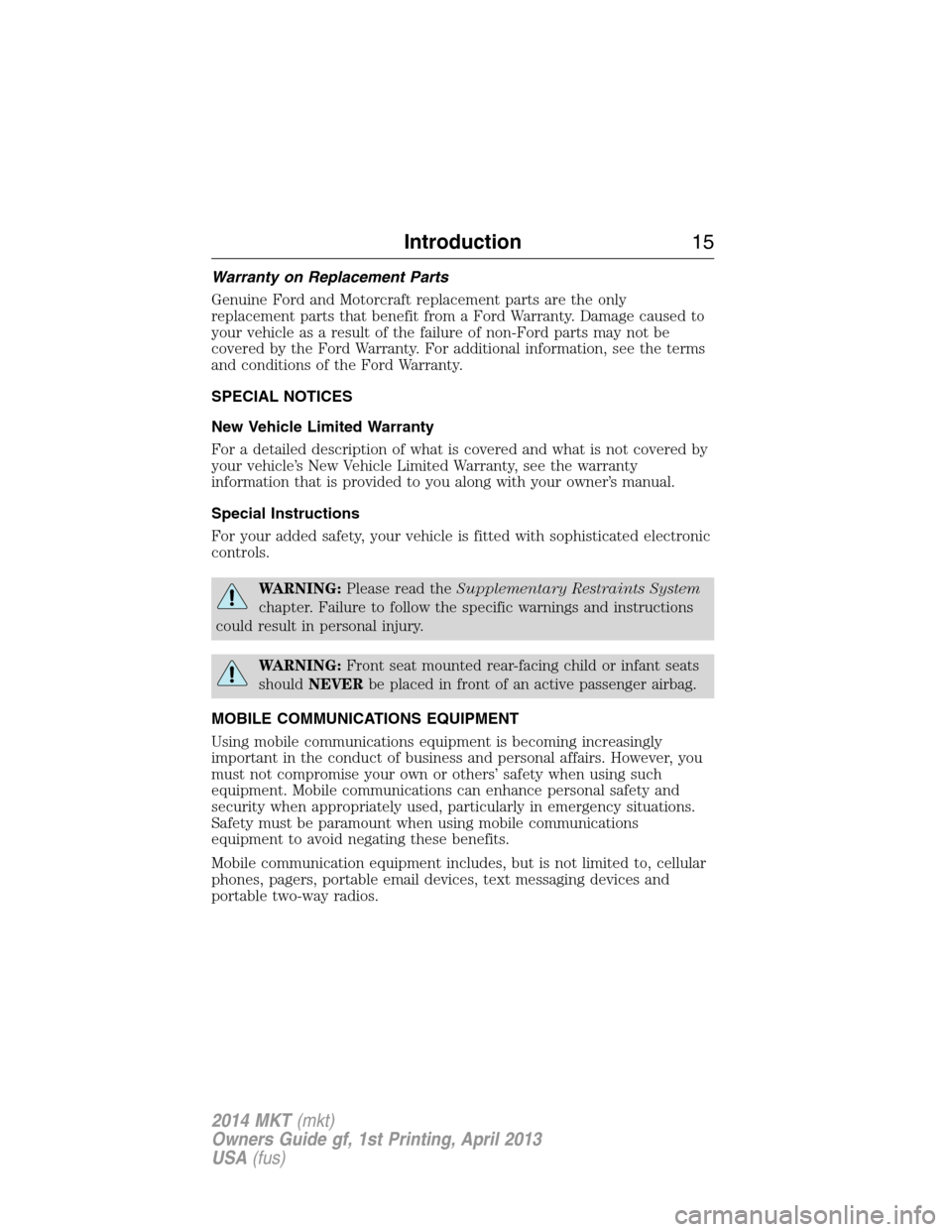
Warranty on Replacement Parts
Genuine Ford and Motorcraft replacement parts are the only
replacement parts that benefit from a Ford Warranty. Damage caused to
your vehicle as a result of the failure of non-Ford parts may not be
covered by the Ford Warranty. For additional information, see the terms
and conditions of the Ford Warranty.
SPECIAL NOTICES
New Vehicle Limited Warranty
For a detailed description of what is covered and what is not covered by
your vehicle’s New Vehicle Limited Warranty, see the warranty
information that is provided to you along with your owner’s manual.
Special Instructions
For your added safety, your vehicle is fitted with sophisticated electronic
controls.
WARNING:Please read theSupplementary Restraints System
chapter. Failure to follow the specific warnings and instructions
could result in personal injury.
WARNING:Front seat mounted rear-facing child or infant seats
shouldNEVERbe placed in front of an active passenger airbag.
MOBILE COMMUNICATIONS EQUIPMENT
Using mobile communications equipment is becoming increasingly
important in the conduct of business and personal affairs. However, you
must not compromise your own or others’ safety when using such
equipment. Mobile communications can enhance personal safety and
security when appropriately used, particularly in emergency situations.
Safety must be paramount when using mobile communications
equipment to avoid negating these benefits.
Mobile communication equipment includes, but is not limited to, cellular
phones, pagers, portable email devices, text messaging devices and
portable two-way radios.
Introduction15
2014 MKT(mkt)
Owners Guide gf, 1st Printing, April 2013
USA(fus)
Page 18 of 498
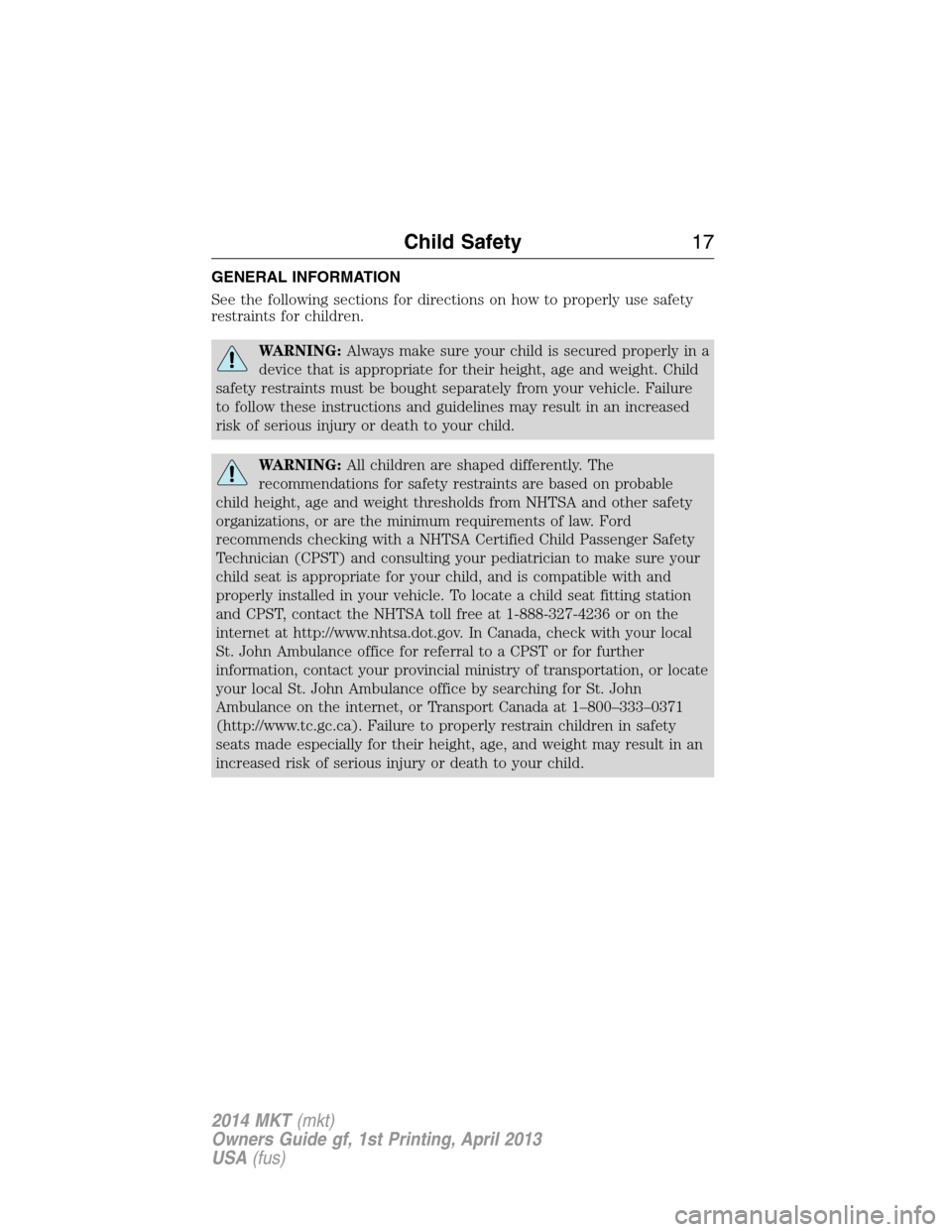
GENERAL INFORMATION
See the following sections for directions on how to properly use safety
restraints for children.
WARNING:Always make sure your child is secured properly in a
device that is appropriate for their height, age and weight. Child
safety restraints must be bought separately from your vehicle. Failure
to follow these instructions and guidelines may result in an increased
risk of serious injury or death to your child.
WARNING:All children are shaped differently. The
recommendations for safety restraints are based on probable
child height, age and weight thresholds from NHTSA and other safety
organizations, or are the minimum requirements of law. Ford
recommends checking with a NHTSA Certified Child Passenger Safety
Technician (CPST) and consulting your pediatrician to make sure your
child seat is appropriate for your child, and is compatible with and
properly installed in your vehicle. To locate a child seat fitting station
and CPST, contact the NHTSA toll free at 1-888-327-4236 or on the
internet at http://www.nhtsa.dot.gov. In Canada, check with your local
St. John Ambulance office for referral to a CPST or for further
information, contact your provincial ministry of transportation, or locate
your local St. John Ambulance office by searching for St. John
Ambulance on the internet, or Transport Canada at 1–800–333–0371
(http://www.tc.gc.ca). Failure to properly restrain children in safety
seats made especially for their height, age, and weight may result in an
increased risk of serious injury or death to your child.
Child Safety17
2014 MKT(mkt)
Owners Guide gf, 1st Printing, April 2013
USA(fus)
Page 25 of 498
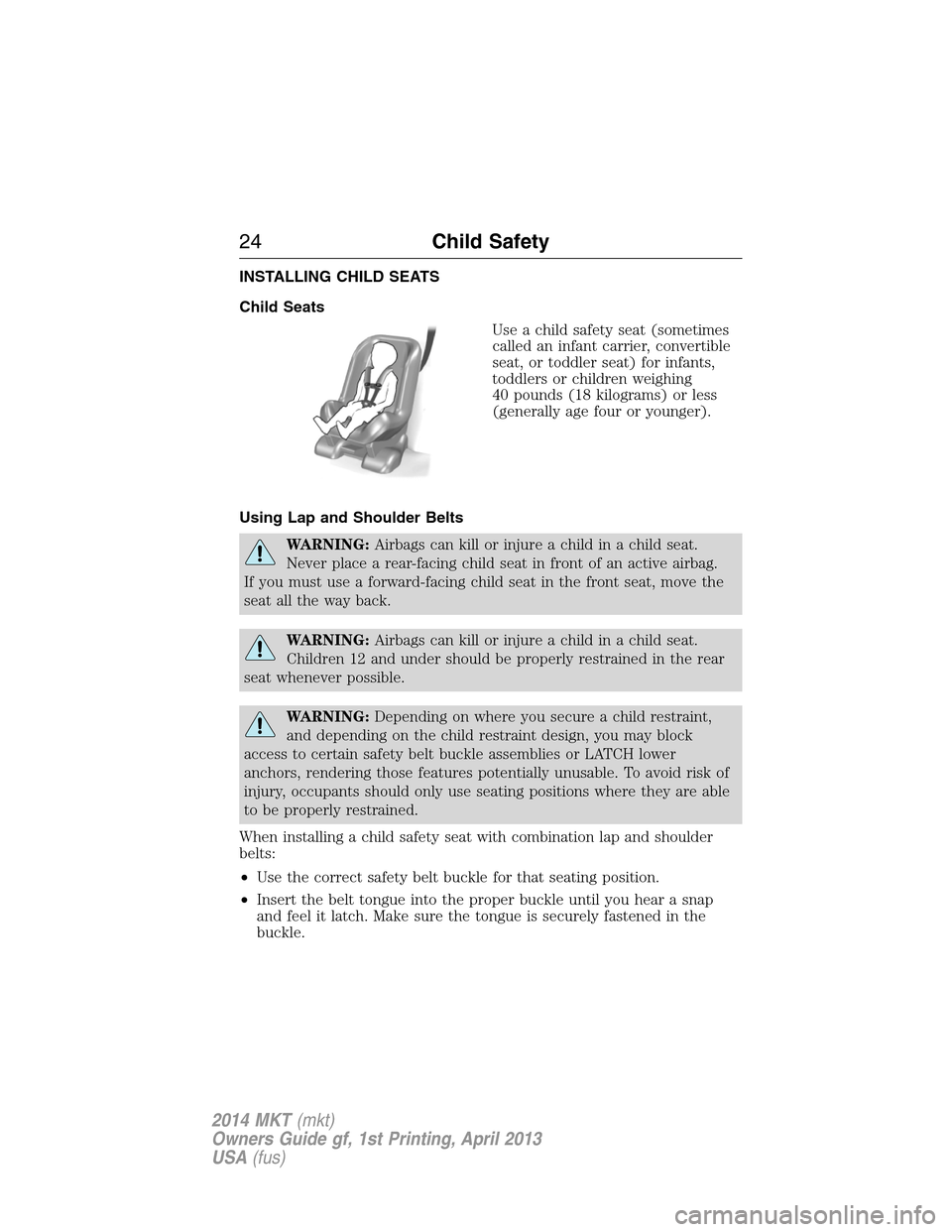
INSTALLING CHILD SEATS
Child Seats
Use a child safety seat (sometimes
called an infant carrier, convertible
seat, or toddler seat) for infants,
toddlers or children weighing
40 pounds (18 kilograms) or less
(generally age four or younger).
Using Lap and Shoulder Belts
WARNING:Airbags can kill or injure a child in a child seat.
Never place a rear-facing child seat in front of an active airbag.
If you must use a forward-facing child seat in the front seat, move the
seat all the way back.
WARNING:Airbags can kill or injure a child in a child seat.
Children 12 and under should be properly restrained in the rear
seat whenever possible.
WARNING:Depending on where you secure a child restraint,
and depending on the child restraint design, you may block
access to certain safety belt buckle assemblies or LATCH lower
anchors, rendering those features potentially unusable. To avoid risk of
injury, occupants should only use seating positions where they are able
to be properly restrained.
When installing a child safety seat with combination lap and shoulder
belts:
•Use the correct safety belt buckle for that seating position.
•Insert the belt tongue into the proper buckle until you hear a snap
and feel it latch. Make sure the tongue is securely fastened in the
buckle.
24Child Safety
2014 MKT(mkt)
Owners Guide gf, 1st Printing, April 2013
USA(fus)
Page 27 of 498
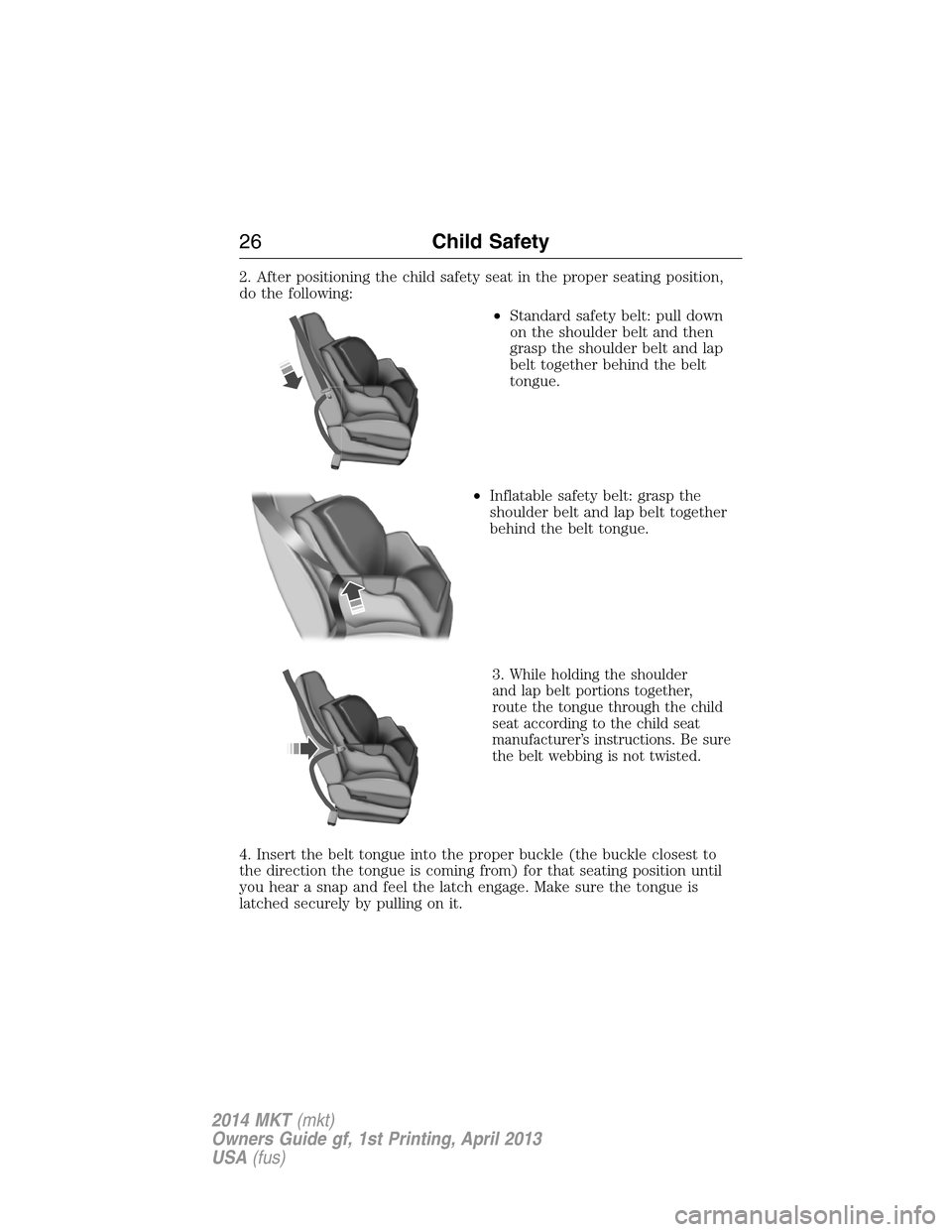
2. After positioning the child safety seat in the proper seating position,
do the following:
•Standard safety belt: pull down
on the shoulder belt and then
grasp the shoulder belt and lap
belt together behind the belt
tongue.
•Inflatable safety belt: grasp the
shoulder belt and lap belt together
behind the belt tongue.
3.
While holding the shoulder
and lap belt portions together,
route the tongue through the child
seat according to the child seat
manufacturer’s instructions. Be sure
the belt webbing is not twisted.
4. Insert the belt tongue into the proper buckle (the buckle closest to
the direction the tongue is coming from) for that seating position until
you hear a snap and feel the latch engage. Make sure the tongue is
latched securely by pulling on it.
26Child Safety
2014 MKT(mkt)
Owners Guide gf, 1st Printing, April 2013
USA(fus)
Page 30 of 498
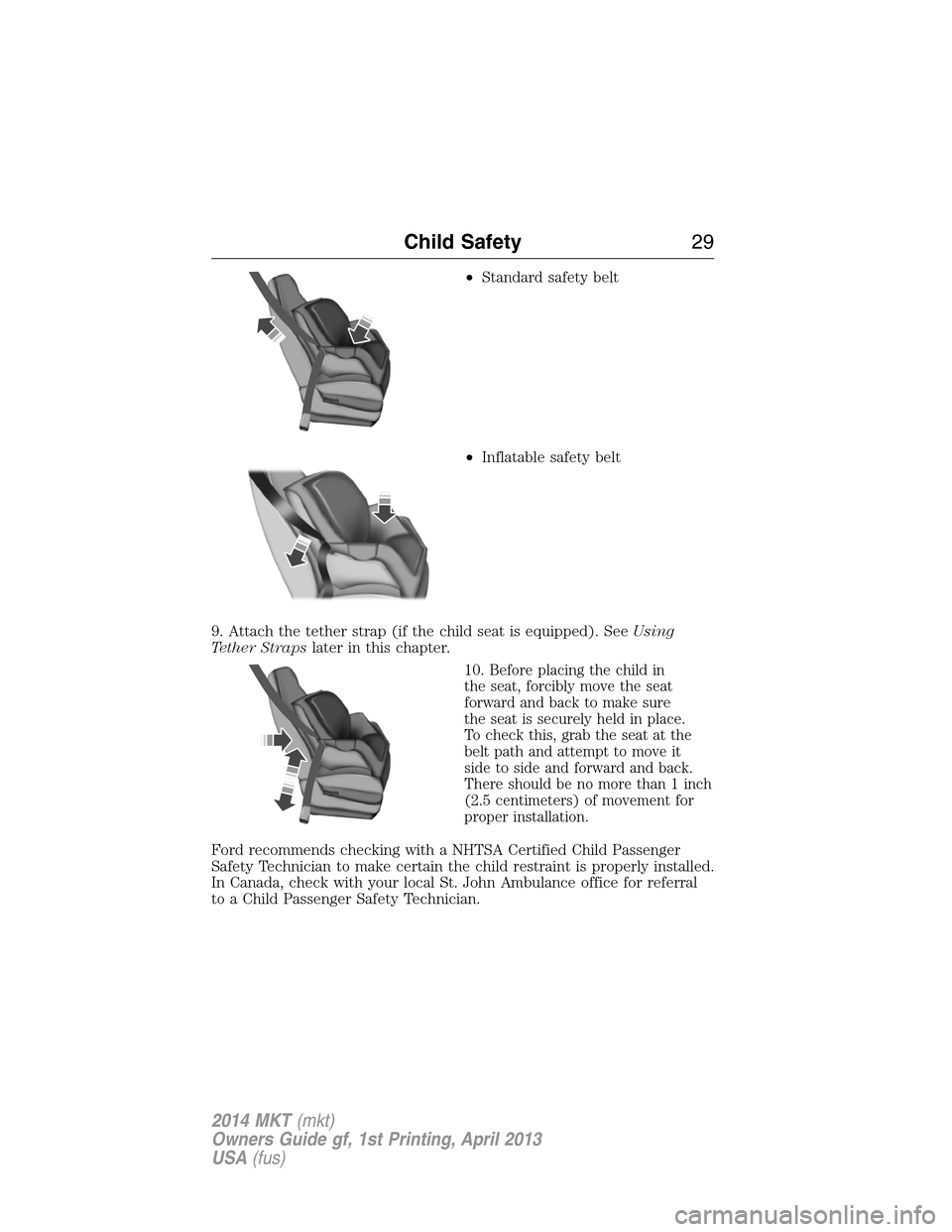
•Standard safety belt
•Inflatable safety belt
9. Attach the tether strap (if the child seat is equipped). SeeUsing
Tether Strapslater in this chapter.
10.
Before placing the child in
the seat, forcibly move the seat
forward and back to make sure
the seat is securely held in place.
To check this, grab the seat at the
belt path and attempt to move it
side to side and forward and back.
There should be no more than 1 inch
(2.5 centimeters) of movement for
proper installation.
Ford recommends checking with a NHTSA Certified Child Passenger
Safety Technician to make certain the child restraint is properly installed.
In Canada, check with your local St. John Ambulance office for referral
to a Child Passenger Safety Technician.
Child Safety29
2014 MKT(mkt)
Owners Guide gf, 1st Printing, April 2013
USA(fus)
Page 31 of 498

Using Lower Anchors and Tethers for CHildren (LATCH)
WARNING:Never attach two child safety seats to the same
anchor. In a crash, one anchor may not be strong enough to hold
two child safety seat attachments and may break, causing serious injury
or death.
WARNING:Depending on where you secure a child restraint,
and depending on the child restraint design, you may block
access to certain safety belt buckle assemblies or LATCH lower
anchors, rendering those features potentially unusable. To avoid risk of
injury, occupants should only use seating positions where they are able
to be properly restrained.
The LATCH system is composed of three vehicle anchor points: two
lower anchors located where seat back and seat cushion meet (called
the seat bight) and one top tether anchor located behind that seating
position.
LATCH compatible child safety seats have two rigid or webbing mounted
attachments that connect to the two lower anchors at the LATCH
equipped seating positions in your vehicle. This type of attachment
method eliminates the need to use safety belts to attach the child seat,
however the safety belt can still be used to attach the child seat. For
forward-facing child seats, the top tether strap must also be attached to
the proper top tether anchor, if a top tether strap has been provided
with your child seat.
Your vehicle has LATCH lower anchors for child seat installation at the
seating positions marked with the child seat symbol.
•Second row bucket seats and
third-row passenger side
30Child Safety
2014 MKT(mkt)
Owners Guide gf, 1st Printing, April 2013
USA(fus)
Page 33 of 498

The lower anchors at the center of the second row rear seat are spaced
20.5 inches (520 millimeters apart). The standardized spacing for LATCH
lower anchors is 11 inches (280 millimeters) center to center. A child
seat with rigid LATCH attachments cannot be installed at the center
seating position. LATCH compatible child seats (with attachments on belt
webbing) can only be used at this seating position provided that the
child seat manufacturer’s instructions permit use with the anchor spacing
stated. Do not attach a child seat to any lower anchor if an adjacent
child seat is attached to that anchor.
Each time you use the safety seat, check that the seat is properly
attached to the lower anchors and tether anchor, if applicable. Tug the
child seat from side to side and forward and back where it is secured to
the vehicle. The seat should move less than one inch when you do this
for a proper installation.
If the safety seat is not anchored properly, the risk of a child being
injured in a crash greatly increases.
Combining Safety Belt and LATCH Lower Anchors for Attaching
Child Safety Seats
When used in combination, either the safety belt or the LATCH lower
anchors may be attached first, provided a proper installation is achieved.
Attach the tether strap afterward, if included with the child seat.
Using Tether Straps
Many forward-facing child safety seats include a tether strap
which extends from the back of the child safety seat and hooks
to an anchoring point called the top tether anchor. Tether
straps are available as an accessory for many older safety seats.
Contact the manufacturer of your child seat for information about
ordering a tether strap, or to obtain a longer tether strap if the tether
strap on your safety seat does not reach the appropriate top tether
anchor in your vehicle.
Once the child safety seat has been installed using either the safety belt,
the lower anchors of the LATCH system, or both, you can attach the top
tether strap.
32Child Safety
2014 MKT(mkt)
Owners Guide gf, 1st Printing, April 2013
USA(fus)
Page 41 of 498
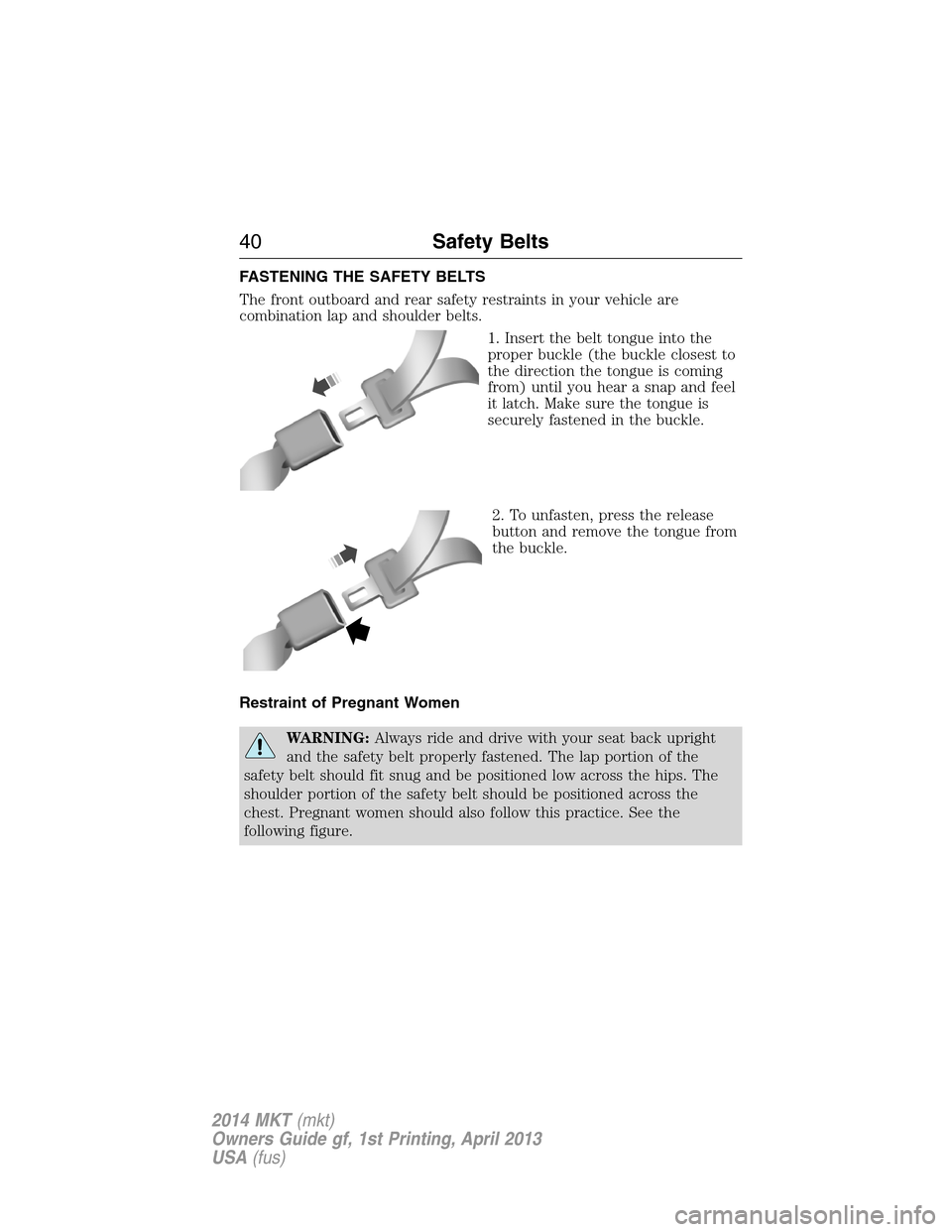
FASTENING THE SAFETY BELTS
The front outboard and rear safety restraints in your vehicle are
combination lap and shoulder belts.
1. Insert the belt tongue into the
proper buckle (the buckle closest to
the direction the tongue is coming
from) until you hear a snap and feel
it latch. Make sure the tongue is
securely fastened in the buckle.
2. To unfasten, press the release
button and remove the tongue from
the buckle.
Restraint of Pregnant Women
WARNING:Always ride and drive with your seat back upright
and the safety belt properly fastened. The lap portion of the
safety belt should fit snug and be positioned low across the hips. The
shoulder portion of the safety belt should be positioned across the
chest. Pregnant women should also follow this practice. See the
following figure.
40Safety Belts
2014 MKT(mkt)
Owners Guide gf, 1st Printing, April 2013
USA(fus)
Page 60 of 498
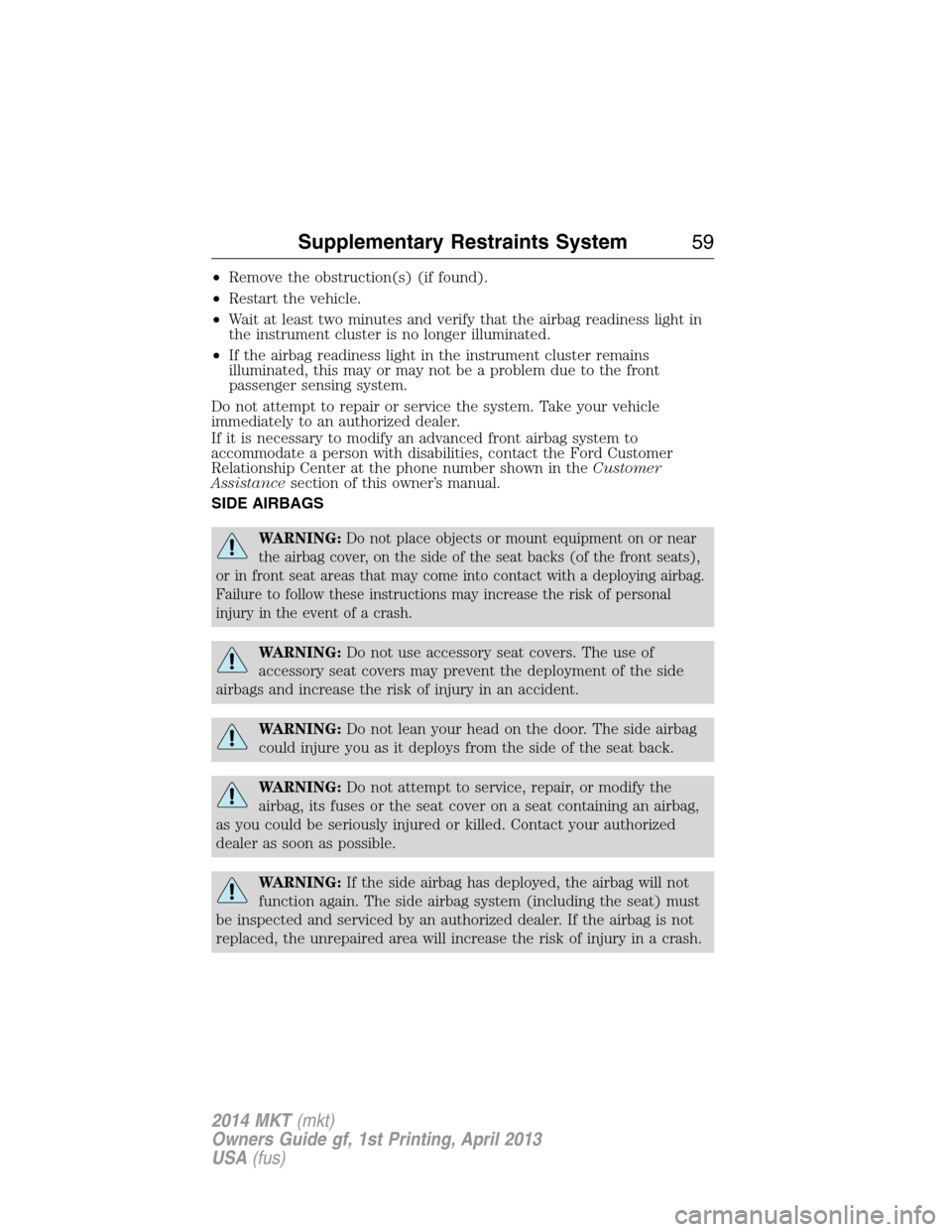
•Remove the obstruction(s) (if found).
•Restart the vehicle.
•Wait at least two minutes and verify that the airbag readiness light in
the instrument cluster is no longer illuminated.
•If the airbag readiness light in the instrument cluster remains
illuminated, this may or may not be a problem due to the front
passenger sensing system.
Do not attempt to repair or service the system. Take your vehicle
immediately to an authorized dealer.
If it is necessary to modify an advanced front airbag system to
accommodate a person with disabilities, contact the Ford Customer
Relationship Center at the phone number shown in theCustomer
Assistancesection of this owner’s manual.
SIDE AIRBAGS
WARNING:Do not place objects or mount equipment on or near
the airbag cover, on the side of the seat backs (of the front seats),
or in front seat areas that may come into contact with a deploying airbag.
Failure to follow these instructions may increase the risk of personal
injury in the event of a crash.
WARNING:Do not use accessory seat covers. The use of
accessory seat covers may prevent the deployment of the side
airbags and increase the risk of injury in an accident.
WARNING:Do not lean your head on the door. The side airbag
could injure you as it deploys from the side of the seat back.
WARNING:Do not attempt to service, repair, or modify the
airbag, its fuses or the seat cover on a seat containing an airbag,
as you could be seriously injured or killed. Contact your authorized
dealer as soon as possible.
WARNING:If the side airbag has deployed, the airbag will not
function again. The side airbag system (including the seat) must
be inspected and serviced by an authorized dealer. If the airbag is not
replaced, the unrepaired area will increase the risk of injury in a crash.
Supplementary Restraints System59
2014 MKT(mkt)
Owners Guide gf, 1st Printing, April 2013
USA(fus)